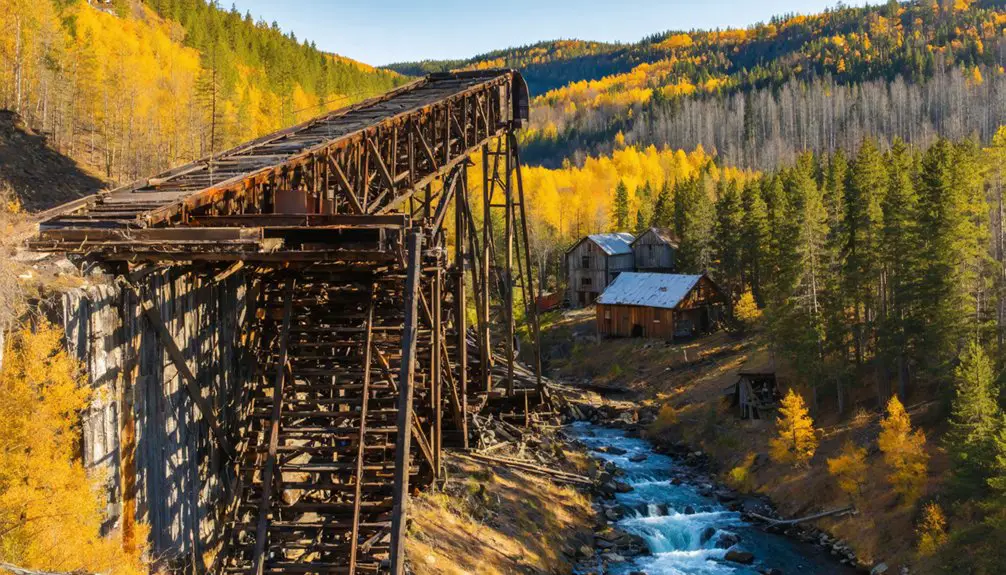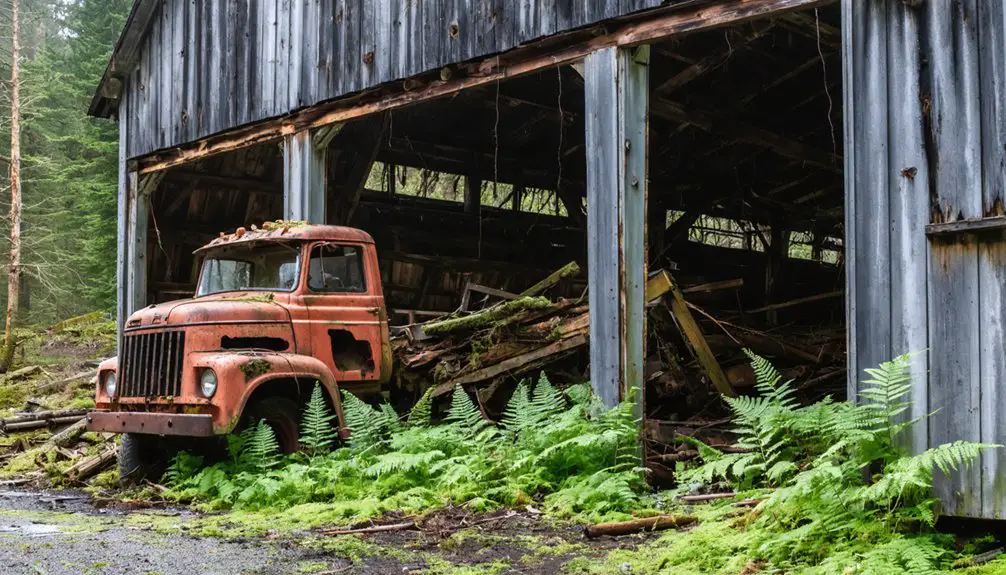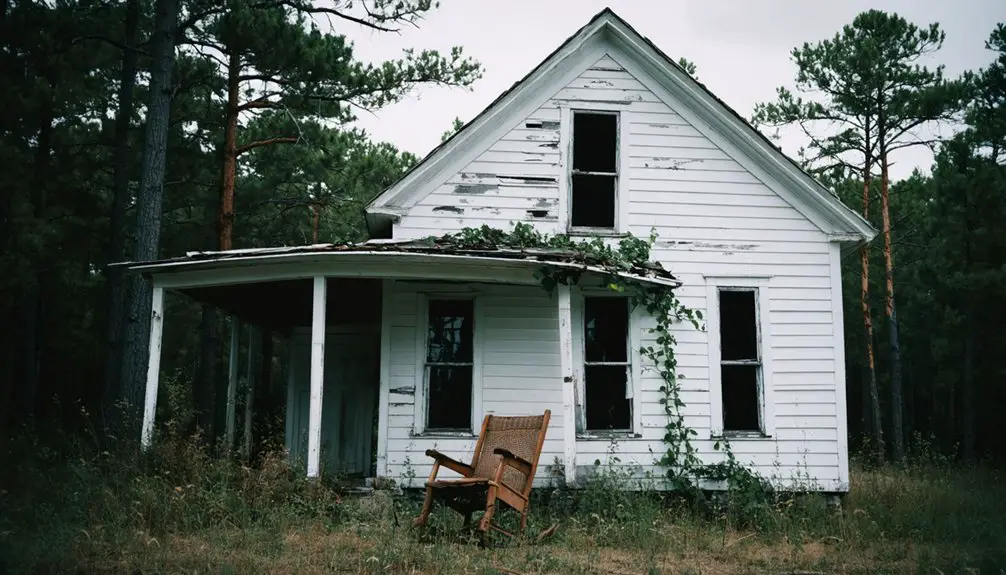You’ll find the ghost town of Malone, Washington nestled in what was once a bustling timber empire. Founded by Hector J. Malone in 1897 with his pioneering shingle mill, the town grew into a company-controlled lumber community served by the Mohawk & Malone railway. Workers lived in company houses, shopped at company stores, and worked grueling shifts until the 1940s timber decline. Today, mill foundations and abandoned buildings whisper stories of this forgotten lumber town‘s heyday.
Key Takeaways
- Malone originated as a lumber town in early 1900s Washington, centered around the Joe Vance Lumber Company’s operations.
- The town functioned as a company-controlled community with workers living in company housing and depending on company facilities.
- Mill operations featured sawmills and shingle mills, with infrastructure capable of storing 7 million board feet of logs.
- Timber industry decline by 1941 led to Malone’s abandonment, leaving only foundations and abandoned buildings as evidence.
- The site contains remnants of the former lumber town, including mill foundations that showcase its industrial heritage.
The Rise of a Lumber Empire
As the early 1900s ushered in America’s timber boom, the Joe Vance Lumber Company established a sprawling mill operation in Malone that would transform the remote Washington settlement into a bustling lumber town.
You’d find an impressive infrastructure of sawmills, boarding houses, and barns, with railroad sidetracks capable of storing 7 million board feet of logs.
The region’s timber transportation relied heavily on the Mohawk & Malone railway line, which strategically paralleled river branches for maximum logging efficiency.
The ingenious Mohawk & Malone railway network traced riverways, creating an optimized system for moving timber across the wilderness.
By spring, you’d see crews starting their seasonal work, peeling pulpwood right at the stumps. The paper industry’s high demand led to importing 40% of pulpwood from Canada by 1904.
The surrounding timberland, owned by moguls like William S. deCamp, stretched across tens of thousands of acres, providing the raw materials that kept logging technology humming year-round. The mill eventually ceased operations when the Great Depression forced its closure.
Life in a Company-Owned Town
If you’d lived in Malone during its heyday, you would’ve found yourself residing in a company-built house near the mill, where every aspect of daily life fell under company control.
Your housing, work schedule, shopping at the company store, and even social activities at the company theater were all carefully managed by mill operators to maintain a stable workforce.
The standardized housing arrangements kept workers close to their jobs while giving management extensive oversight of the community, creating a way of life that was common to Pacific Northwest lumber towns of the early 1900s.
Similar to how Hunters Capital focuses on investing in buildings and community today, the mill operators maintained tight control over their real estate holdings.
The logging industry dominated local employment throughout the 1920s, providing the economic foundation for this tightly controlled community.
Control Through Company Housing
While many historical mining towns offered workers independence in their living arrangements, Malone operated under complete company control through its housing system.
You’d find yourself living in company-owned homes where your shelter directly depended on maintaining employment. Much like Molson’s worker housing, which provided accommodation for brewery employees in Montreal during the company’s early years, the housing dependency extended beyond just having a roof over your head – it shaped every aspect of daily life.
Through strategic placement of company stores and entertainment venues near the housing areas, you couldn’t escape social control even during leisure hours. Similar to how Camp Grisdale housed its workers in planned communities, the company maintained strict oversight of daily life.
If you were a miner, you’d likely find yourself segregated with others of your ethnicity in designated rows of cottages. The company maintained strict oversight of maintenance, enforced rigid rules about behavior, and could evict you at any time – especially if you participated in labor protests.
Mill Work Daily Reality
Once you stepped into Malone’s lumber mill operations in the early 1900s, you’d find yourself caught up in the demanding rhythm of industrial logging life.
Worker experiences revolved around physically exhausting shifts at the sawmill and shingle mill, where you’d face daily labor challenges alongside fellow crew members. The Vance Lumber Company employed hundreds of workers to keep its massive operation running in Grays Harbor County. The company maintained operations until Bordeaux Lumber Company took over around 1922.
- You’d operate heavy machinery and handle timber products under hazardous conditions typical of early 20th-century logging operations.
- Your workday would involve manual cutting, loading, and transport using jitneys and donkey engines.
- You’d spend long hours meeting production demands with minimal worker protections.
- Your livelihood would depend entirely on the mill’s success, with wages often tied to credit at the company store.
The mill’s relentless pace defined your existence, shaping both your work life and social interactions within the industrial logging community.
The Legacy of Hector J. Malone
If you’re exploring Washington’s ghost towns, you’ll find Hector J. Malone‘s enduring impact in the town that bears his name, where he established the first shingle mill in 1897 along Moxie Creek.
His vision transformed raw forestland into a thriving industrial hub, laying the groundwork for what would become a complete company town under later operators like Vance Lumber Company and Bordeaux Lumber Company. Located fifteen miles east of Montesano in Grays Harbor County, the settlement grew into a significant logging center.
You can still trace Malone’s pioneering spirit in the remaining mill foundations and abandoned buildings, which stand as evidence of his role in launching the region’s logging empire and establishing a blueprint for Pacific Northwest company towns.
Pioneer Mill Town Founder
The pioneering spirit of Hector J. Malone shaped the destiny of a Washington mill town that would later bear his name. In 1897, alongside William Malone, he established the area’s first shingle mill, demonstrating remarkable founder influence through his industrial vision.
His leadership in mill operations created a hub of economic activity that transformed the wilderness into a thriving community. When attempting to locate historical records of the mill today, visitors may encounter page not found errors due to the limited preservation of early documentation.
- Founded the original shingle mill that became the town’s economic engine
- Attracted workers and families, establishing the foundation for population growth
- Sparked infrastructure development, including the crucial Malone’s rail spur
- Created an industrial legacy that defined the region’s early development
You’ll find Malone’s impact woven into every aspect of the town’s history, from its bustling beginnings to its eventual ghost town status.
Logging Empire Development
Under Hector J. Malone’s leadership, the establishment of the first shingle mill in 1897 launched a transformative logging empire.
You’ll find his innovative logging techniques centered around Moxie Creek, where donkey engines and mechanized equipment revolutionized timber harvesting efficiency.
The operation’s economic sustainability hinged on Malone’s company town model, where he maintained complete control over land, buildings, and infrastructure.
You can trace his influence through the remains of company houses, stores, and entertainment facilities that once served the logging community.
His concentrated industrial efforts created a self-sufficient timber processing hub that dominated regional markets.
Today, you’ll see only abandoned mills and boarded-up buildings, silent testimonies to Malone’s once-thriving logging enterprise that shaped Northwestern timber industry practices and community development patterns.
Community Building Vision
Beyond his industrial achievements, Hector J. Malone envisioned a self-contained community that would foster worker solidarity while maintaining company control. You’ll find his influence reflected in every aspect of the town’s carefully planned infrastructure, from worker housing to social spaces.
His community building vision emphasized:
- Strategic placement of company-owned facilities to create natural gathering spots
- Development of essential services like the company store to keep workers close to home
- Construction of entertainment venues, including a theater, to boost community engagement
- Implementation of company-controlled housing to maintain workforce stability
You can still see Malone’s lasting impact on the town’s layout today, even as abandoned buildings stand as silent witnesses to his ambitious vision of creating a thriving, company-centered community in Washington’s logging frontier.
Industrial Operations at Moxie Creek

Located along Moxie Creek, 15 miles east of Montesano, Malone’s industrial operations began in 1897 when Hector J. Malone established his shingle mill, marking the start of significant timber processing in the area.
You’ll find that industrial growth accelerated when Joe Vance Lumber Company opened their lumber mill before 1908, which later became Bordeaux Lumber Company around 1922.
At its peak, you’d have seen a bustling operation with donkey engines hauling logs, workers managing massive woodpiles, and mills converting raw timber into finished lumber and shingles.
Steam-powered donkey engines roared as workers guided heavy timber through busy mills, transforming forest giants into valuable lumber products.
The company-owned town featured worker housing and essential facilities supporting the timber industry.
While nothing remains of the once-thriving industrial center today except ruins, Malone’s legacy as a timber processing powerhouse lives on through its mill remains along Moxie Creek.
Daily Life and Community Structure
Although Malone began as a company town, it quickly developed into a vibrant community where timber workers and their families established deep social roots.
Community activities centered around essential gathering spots that fostered social interactions between diverse residents including miners, ranchers, and merchants.
- You’d find the Hotel Tonasket serving as the social hub, with its 34 rooms hosting visitors until its devastating fire in 1924.
- The local paper, *The Molson Leader*, kept you informed of community happenings and local disputes.
- You could enjoy entertainment at multiple saloons and the town dance hall.
- The railroad station, Washington’s highest at 3,708 feet, connected you to the broader region while local shops and services met daily needs.
The Decline of the Timber Industry

While Malone’s timber industry thrived in the early 1900s, multiple factors converged to seal its fate by 1941.
You’d have seen the writing on the wall as nearby old-growth forests were steadily depleted, forcing a shift toward managed tree farming. The town’s decline accelerated as raw materials became scarce and mill operations struggled to remain viable.
Later timber regulations in the 1980s-90s would reshape the entire Washington state industry, but Malone’s story had already ended decades earlier.
Economic shifts hit similar company towns hard – from Canadian competition to industry consolidation. While some surviving mills adapted with improved technology and efficiency measures, Malone couldn’t overcome its fundamental challenge: the exhaustion of local timber resources that had been its lifeblood.
Preserving Malone’s Historical Remnants
Since 1960, preservation efforts in Malone have centered around the Old Molson Ghost Town Museum, established by Harry Sherling to showcase the area’s pioneering heritage.
You’ll find artifact preservation throughout the site, with period-appropriate staging and historical photos bringing the town’s story to life.
Visitor engagement opportunities include:
- Free admission during daylight hours year-round
- Self-guided tours through authentic pioneer buildings and company structures
- Displays of farming machinery and wagons in outdoor exhibits
- Access to the complementary Molson Schoolhouse Museum nearby
While some buildings remain boarded up and certain artifacts lack complete labeling, local organizations and volunteers work tirelessly to maintain these historical treasures.
The preservation network extends beyond Malone, connecting with other regional sites to create a thorough historical experience.
Frequently Asked Questions
What Happened to the Families Who Lived in Malone After It Closed?
You’d find families scattered as they faced tough historical impacts, with most relocating within Grays Harbor County for mill work, while others moved to cities like Aberdeen or left Washington entirely.
Are There Any Ghost Stories or Supernatural Legends Associated With Malone?
You won’t find documented ghost sightings or supernatural occurrences from Malone in official records, though local hikers occasionally share unverified stories about strange sounds from the abandoned mill ruins.
Can Visitors Legally Explore the Remaining Structures in Malone Today?
Hold your horses – you can’t legally explore Malone’s structures today without explicit permission from property owners. Legal access is restricted due to private property rights and safety concerns.
How Many People Lived in Malone During Its Peak Population?
You’ll find that Malone’s history doesn’t document an exact peak population, though current demographics show 468 residents as of 2020. Historical records don’t reveal earlier population figures with certainty.
What Artifacts Have Been Found in Archaeological Surveys of Malone?
You’ll find industrial hardware, sawmill equipment, logging tools, glass fragments, pottery shards, and household items from company housing sites, discovered through systematic subsurface testing of this historic logging center.
References
- http://www.ghosttownsusa.com/molson.htm
- https://en.wikipedia.org/wiki/Molson
- https://revisitwa.org/waypoint/malone/
- https://visitrainier.com/melmont-ghost-town-2/
- https://www.discoverorovillewa.com/post/old-molson-ghost-town
- https://www.newyorkalmanack.com/2022/12/the-mohawk-malone-forest-fires-logging-south-of-big-moose-1900-1920/
- https://archiveswest.orbiscascade.org/ark:/80444/xv48913
- https://www.historylink.org/File/23147
- https://www.nps.gov/parkhistory/online_books/olym/hrs/chap3.htm
- https://foresthistory.org/wp-content/uploads/2022/05/Kreienbaum_C_H.pdf



